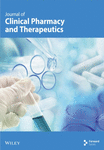Appropriateness of a 4 mg/kg gentamicin or tobramycin loading dose in post-operative septic shock patients
Abstract
Objective: To determine the frequency with which early adequate peak serum concentrations (6–12 mg/litre) can be achieved following a 4 mg/kg loading dose of gentamicin or tobramycin in post-operative septic shock patients. Method: Eleven post-operative septic shock patients were grouped into (i) a control group ( n=7) who received the conventionl gentamicin or tobramycin dosing regimen of 2 mg/kg loading dose followed by a maintenance dose of approximately 1·5 mg/kg (peak and trough levels were measured after the third dose), and (ii) a study group ( n=4) who received a tobramycin or gentamicin 4 mg/kg loading dose, followed by 30 min, 3 h and 16 h serum drug level measurements. Pharmacokinetic parameters were calculated using a one-compartmental model. Differences in both groups were determined using Student's t-test. Results: Pharmacokinetic parameters in both groups showed no statistically significant difference. The dose from which peak levels were drawn was significantly higher in the study group (4 mg/kg vs. 1·66 mg/kg; P=0·001), which also resulted in higher but adequate peak serum concentrations (8·9±2·2 vs. 4·8±1·8 mg/litre). In the study group, linear regression analysis showed significant relationships between dose and peak concentrations and volume of distribution and peak concentrations ( r=0·96, P=0·01 and r=−0·96, P=0·01, respectively). Conclusion: One hundred per cent of the post-operative septic shock patients achieved target peak serum concentrations (mean 8·9±2·2 mg/litre) following a 4 mg/kg tobramycin or gentamicin loading dose. An expanded Vd (0·46±0·13 litres/kg) was also observed.




